56TH ANNUAL CONFERENCE, Toronto, Canada, 15-19 May 2017WP No. 154CISM Programmes Throughout IFATCA Member AssociationsPresented by PLC |
Summary
Critical Incident Stress Management is a comprehensive, integrated, systematic and multicomponent crisis intervention programme developed to help managing traumatic experiences. IFATCA has been a great advocate for creation of CISM programmes in the world of ATM. The longer people are not working at their normal performance levels, the more this has an effect on the performance of the overall system. Organised and well trained CISM teams can help organisations providing air traffic control services to become high resiliency organisations. The paper presents the basic elements of the program as well as a generic approach to the current situation throughout IFATCA member associations.
Introduction
1.1 Critical incidents are events that are so unusual or powerful that they can overwhelm the coping capacity of those who are exposed to them. They may generate a strong emotional reaction called crisis typically accompanied by cognitive, emotional, physical and behavioural manifestations of stress which eventually may lead to unclear, disorganised thinking and mistake occurrences.
1.2 When a critical incident occurs no one knows for certain how affected staff will react and to what extent the incident will affect their day-to-day life as well as their job performance. Critical incidents can be the starting point for a crisis reaction and sometimes are perceived to be overwhelming and threatening circumstances.
1.3 Critical incident stress management concept was introduced into the emergency services field in 1974 (although not called CISM until the mid-1980s) when it was developed to assist police officers, firefighters, emergency medical and military personnel. Over the last decades CISM support services have extended well beyond their original intended target population now including the school systems, industrial sector and of course, aviation. First development of CISM programmes in air traffic services has taken place in the aftermath of air disasters in an attempt to mitigate and decrease the psychological impact on the air traffic controller: DC-10 crash at the airport of Sioux City in 1989, B-747 crash on an apartment building in Amsterdam in 1994, Linate airport disaster in 2001, mid-air collision over Lake Constance in 2002, GOL flight 1907 in 2006 in Brazil. In recent years several ANSP´s have progressed in implementing a CISM programme.
1.4 IFATCA has always been a great advocate for the creation of CISM in the world of ATM. In collaboration with EUROCONTROL, Deutsche Flugsicherung GmbH (DFS), Skyguide, and the International Critical Stress Foundation (ICISF) several workshops and seminars have been organised aiming at raising awareness about the effects of critical incidents on individuals following a traumatic event and offering help to MAs to further progress with their programmes.
1.5 Cost benefit studies have shown the positive effects of having implemented a CISM programme. For example, studies which have been done in the Deutsche Flugsicherung (DFS) have demonstrated a positive cost benefit factor of 1:3 (M. Barbarino, HF Domain Eurocontrol)
1.6 An ATC CISM programme is a peer support programme and its greatest chance of success is when developed by the management and air traffic controllers working together.
1.7 The introduction of CISM programmes has been a harmonisation objective in the European Convergence and Implementation Plan (ECIP, 2007) and, at present, the work programme approved under the European Aviation Safety Plan 2014-2017 includes the CISM together with other strands of works such as Fatigue Management, Safety Human Performance Dissemination and Toolkits, Degraded Modes, Safety and Team Works Factors.
1.8 Findings show that many IFATCA Member Associations lack of the implementation of such a programme.
Discussion
2.1 What is a critical incident?
“Any situation that causes a person to experience unusually strong stress reactions that the person perceive as disturbing or disabling” (EUROCONTROL, Critical Incident Stress Management: User Implementation Guidelines). Experience shows that different people experience critical incidents in different ways. A group of people experiencing the same incident may reveal patterns of critical stress reactions of different qualities and intensities. The individual ´s perception of the event and his/her response to the situation is the essence of a crisis. It must be pointed out that the reaction towards a critical incident does not only depend on the incident itself but also on the mental and physical condition on the person affected. “Any situation causing reactions perceived as unusual by the affected person can be a Critical Incident since it depends more on the psychological status of the involved person than on the incident itself” (Leonhardt and Vogt, 2006)
Stress reactions show either immediately after the exposure to the incident or up to several weeks later and can be divided into four categories listed by Woldring in the Eurocontrol Human Factors Module Stress, 1996. Find a selected list below:
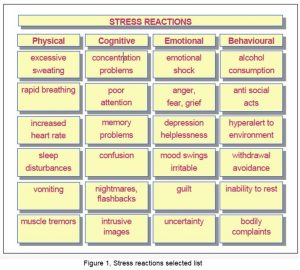
2.2 What is a Critical Incident Stress Management Programme?
2.2.1 Following EUROCONTROL definition (Human Factors Module. Critical Incident Stress Management, 1997) it can be said that a Critical Incident Stress Management program is the “structured assistance for a normal reaction to an abnormal event” emphasising that it is the critical incident that is abnormal while the stress reaction to such an event is a normal human reaction. Furthermore, following Jeffrey T. Mitchell definition, it is said to be a “comprehensive, integrated, systematic and multicomponent crisis intervention program developed to help manage traumatic experiences within organisations and communities” (Jeffrey T. Mitchell, 1997)
2.2.2 CISM main goals are to:
- Mitigate the impact of a traumatic event
- Facilitate normal recovery processes
- Restore individuals or groups to adaptive functions
- Identify people within an organisation who would benefit from additional support services or a referral for further evaluation
2.2.3 Primary principles of crisis intervention:
- Proximity. Crisis work should be provided in those surroundings that are familiar to the people who need support.
- Immediacy. Help should be provided as soon as possible after the exposure to a traumatic experience.
- Expectancy. The provider of crisis intervention should instill some hope that it is possible to manage and resolve the situation.
- Brevity. Actions to assist people should be brief though rushing may compromise the final goal.
- Simplicity. In the midst of a crisis complexity is not very well handed. The crisis support provider should focus on solutions that are easy for a distress person to apply.
- Innovative. It is usually helpful that crisis workers have some creativity when they are working in extraordinary and challenging situations
- Practical. Crisis support personnel should avoid suggestions that are impractical.
2.2.4 CISM is not a form of psychotherapy nor a substitute for psychotherapy. All CISM components should be part of a package of interventions since those components have not been designed to be used as standalone intervention. It is said to be:
- Comprehensive because it promotes pre-event stress and crisis management education, planning and policy development, training and preparation;
- Integrated because all components are linked and blended together into a cohesive approach for use in crisis intervention;
- Systematic because the elements of a CISM program are applied in a logical, step-by-step manner; and
- Multi-component because it has many parts that are interlocked. The 7 core components are summarised as follows:
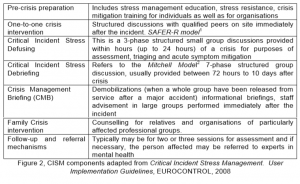
Note 1: SAFER-R Model: method for approaching to individual crisis intervention, Dr. George Everly, 2001.
Note 2: Mitchell Model: method designed to mitigate acute symptons, assess the need for follow-up and if posible provide a sense of post-crisis psychological closure, Mitchell and Everly, 1996.
2.2.5 CISM methods are preventive measures consisting of discussions about the incidents in the form of structured individual or group discussions and help the person affected regain his/her ability to apply coping strategies.
2.2.6 The use of peer support personnel is one feature that makes CISM programs unique. Peers, colleagues trained in CISM techniques, play the most active and effective role in CISM programmes since they enjoy immediate credibility among their fellow workers, they share same professional understanding of job related processes so they can deeply understand how someone feels after a job-related critical incident. Especially in aviation, peers are the backbone of any CISM program. They should be motivated, experienced and trusted by their colleagues.
2.2.7 CISM consists of three phases:
- Phase I: The information phase: provides a basic overview of what CISM is about, describes potential reactions to critical incidents and explains different CISM support mechanisms.
- Phase II: The training phase: Provides more detailed information about critical incident stress and its management. Peers are trained how to support their colleagues after an incident.
- Phase III: The support phase: Consists in the set of services assisting the person involved, either an informal chat, a more formal meeting either individually (defusing) or in a group (debriefing).
2.2.8 The SAFER-R Model
Dr. Everly developed an approach to individual crisis intervention that was called the SAFER-R Model. Each letter has the following meaning:
- S stands for stabilize the situation by eliminating the stimuli that might make the situation worse. Involves introductions and seeing that basic needs are meet within an environment of safety.
- A stands for acknowledgment of the event by listening to the who, what and when but trying to move away from the why and how because those two tend to lead to judgment statements and it is important to stay with the facts.
- F stands for facilitate the expression of difficult emotions, helping people to understand the impact of the critical event. It is time to attribute reactions and emotions to the situation and not to personal weakness.
- E stands for encourage and offers the opportunity for the team member to teach or recommend some stress management tools such as avoiding known stressors, relaxation response training, nutritional techniques, physical exercise, etc.
- R-R stands for resolution by assessing the person´s ability to safely function or referral by for additional professional support.
2.2.9 The Mitchell Model
Dr. Jeffrey T. Mitchell and Georges S. Everly developed and validated a structured debriefing model for crisis intervention in groups consisting of seven phases. It was developed for homogeneous groups who have encountered a powerful traumatic event aiming at a reduction of distress and restoration of group cohesion and unit performance. It has proven very helpful and efficient in many different field operations, i.e. fire fighters, rescue services, airlines, etc. (Critical Incident Stress Management in Aviation, Jörg Leonhardt and Joachim Vogt, 2006) There are some other debriefing models (i.e Dyregrov, Raphael, Armstrong et al.) but vast majority of teams involved in debriefing use the Mitchell Model (EUROCONTROL, Critical Incident Stress Management, 2004). The method should ideally be run in collaboration with a mental health professional within two to five days after the incident. The seven phases are as shown in Figure 3.
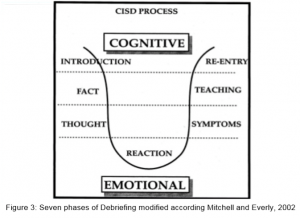
2.2.10 The Peer Model
CISM centers on the involvement of peers from the same professional environment. Some key advantages are:
- Colleagues are often better accepted than individuals from outside the profession.
- CIS reactions may be better understood by peers from same occupational group. They may even have experienced similar reactions at any other time.
- Having the same professional qualification provides peers with a better understanding of the facts and circumstances.
- Being able of understanding the feeling of guilt is a key point and this is easier for peers.
- Peers speak same professional language.
- Air traffic controllers are often more reticent to get involved with mental health professional.
2.3 Establishment of training courses
2.3.1 The strength of any crisis intervention program lies in its ability to reliably develop and enhance skill sets for crisis interventionists. Standardized training curriculum has been created by the International Critical Incident Stress Foundation, ICISF, 2005 consisting on four workshops, 14 hours each :
(1) Assisting individuals in crisis. Introductory course that emphasises an overview of crisis intervention principles and CISM core components.
(2) Group crisis intervention, focuses on assisting the participant in developing skills to deal with those in crisis in groups.
(3) Strategic response to crisis, at which trainees practice the skills for both assessing the needs of those in crisis and developing a comprehensive multicomponent response to complex crisis situations.
(4) Suicide: Prevention, Intervention and Postvention, designed to provide trainees with the knowledge and strategies to recognise, prevent and respond to suicidal individuals.
2.3.2 The ICISF core curriculum has been adapted to suit some ANSP needs. Training should address all levels in the organisation because most of the ATS personnel become involved in a CISM programme: operational team can be exposed to a critical incident, or they may want to help colleagues, while CISM policy and procedures should be agreed by management together with staff representatives.
2.3.3 On one hand, an efficient way to continue the education on CISM is to introduce it into the current training curricula the same way as human factors and stress management are often included as per staff at all levels. On the other, peer de-briefers should receive in addition specific training on both CIS (Critical Incident Stress) and CISM techniques and keep it continuously updated and refreshed. Management should ensure this continuous qualification of the peers.
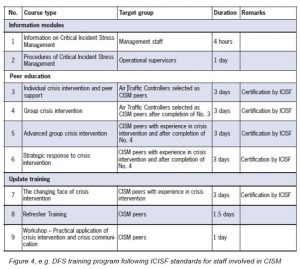
2.4 Evaluation of the CISM program: quality management (QM)
Benefits of CISM have to be evaluated and assessed in the short, medium and long term both at individual/operator´s level but also on the strategic and corporate level. That is, to continuously improve performance and to increase satisfaction within the organisation, a feedback loop into all stages of CISM is required. To enable ANSPs to match a CISM QM with their existing QM programmes, following issues need to be considered:
2.4.1 Quality of structure: the available infrastructure for performing (e.g. qualification of peers, CISM standards; working conditions for peers, management support and organisation commitment)
2.4.2 Quality of processes: the features of the performance process (e.g. selection and training of peers, the quality of their interventions, feedback and monitoring of results)
2.4.3 Quality of results: The results of the CISM programmes (e.g. reduced sick days, increased professionalism)
2.5 CISM within IFATCA
2.5.1 IFATCA policy is:
| Stress prevention at the work place has proved particularly effective in combating stress, by attacking its roots and causes, rather than merely treating its effects.
The Federation recognizes the importance of stress management for air traffic controllers and recommends that, at regular intervals, air traffic controllers are provided with up-to-date information on stress management techniques. The Federation urges MAs to bring to their administration´s attention the stressinducing potential of their work environment in order that particular consideration is given to ensure that the work environment is suitable and as stress-free as possible. The Federation endorses the use of professionally trained peers in the provision of critical incident stress management (CISM) to colleagues experiencing critical incident stress (CIS) Critical incident stress management (CISM) is a wide range of programmes and intervention strategies which have been designed to mitigate the impact of stress in personnel and to assist them in managing and recovering from significant stress. (Adapted from Jeffrey Mitchell Ph.D.)(San José 86.C.6-8, amended Taipei 97.C.6) Comprehensive and confidential support services should be available at all times for air traffic controllers, support staff and their families. Professional critical incident stress support services should be made available to air traffic controllers involved in ATC incidents/accidents and any other occurrences that have potential to create critical stress reactions influencing the ATCO´s performance. It is the controllers´ choice whether or not to take advantage of these support services. |
(IFATCA Technical and Professional Manual, 2015, page 4228)
2.5.2 CISM NETWORK: Supporting each other
Aviation has developed a remarkable safety record with number of accidents decreasing by 5% in 2015 (ICAO Safety Report, 2016 Edition)(see Figure 5). That being said, it also true that disasters, crashes and major crisis can never be ruled out.
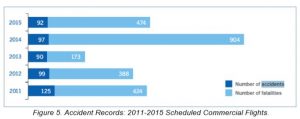
National and corporate culture do play a role in the way in which crisis are handled. Each culture qualifies crises in a different way and the intensity of its concrete experience with national crises determines the structure of the individual crisis intervention programmes. There is a connection between national culture and the handling of stress reactions. However, despite the cultural differences in organisations, the physiological-neurological stress reactions after critical incidents are very similar in all cultures, even if some symptoms may be more or less pronounced in some cultures that in others (Joannidis, 2006)
While the crisis intervention measures remain the same, some cultural aspects have to be taken into account when different countries cooperate (i.e. if a hierarchy has to be taken into account, or if suitable or not for a woman to counsel a man…) CISM- trained controllers and peers from DFS went to Switzerland to support the Swiss ANSP following the Überlingen accident in July 2002. The Portuguese CISM team supported its Brazilian colleagues after the mid-air collision over the Amazon jungle in 2006. All parts involved highlighted the positive effects of this kind of activities. These successful examples of international crisis intervention work should be organised formally and professionally on a regular basis to be prepared when disaster strikes and that is where IFATCA can play a major role by fostering a network of CISM coordinators not only cross border intervention oriented but providing with a forum where coordinators could meet and discuss issues such as organisational, budgetary, training needs, share experiences and best practices as well as identify additional developments and features needed to be introduced. Such a forum could also support newcomers who are considering implementing CISM by providing support with the implementation steps.
2.6 Relationship between Safety Culture and establishment of CISM programmes
The way organisations handle crisis situations may reflect how it perceives its own safety culture. Thanks to a combination of personal disposition, training and daily experience, air traffic controllers are able to deal with unusual, complex and dynamic situations. Prof. Dekker would say that “they create safety through practice” (Dekker, The field guide to understanding Human Error, 2004) but emergencies and unusual situations can also lead to reactions which are either unusual, unusually prolonged or which cannot be handled without assistance. A crisis can trigger reactions in a person that he does not expect (i.e. high pulse, anger, uncertainty, isolation…) and difficult to reconcile with their professional self-image. If the corporate culture surrounding that person is that in which trust is not cultivated, not systematic approach to the critical incident is developed and only the professional at the sharp-end carries the ultimate responsibility, then individual copping strategies are likely to be suppressed. For this reason, an organisation´s corporate safety culture plays a key role in the management of personal crisis. CISM programmes have a positive effect on safety culture. CISM allows people to deal with incidents more openly and this promotes a learning culture and a more open reporting culture minimising the idea of a blame and punitive culture in order to achieve a Just Culture environment. In fact, in order to lay the basis for the emergence of Just Culture, it is proposed by EUROCONTROL “to implement or review the effectiveness of your CISM programme, a crucial ingredient in helping controllers assume that incidents will never be completely avoided, that they can help the organisation to improve, and that they can happen to everybody (A staggered approach to building your Just Culture, Just Culture Guidance Material, Eurocontrol, 2008).
2.7 Data about CISM active programmes running in different IFATCA member associations
IFATCA conducted a survey by electronic means addressing each and every one of the Officials and Representatives listed at the IFATCA A55 Manual (2016) to consult about the current situation of CISM programmes around our MA’s. Nevertheless the response was not as good as expected. Results are shown in Annex 1.
Conclusions
3.1. Stress reactions to critical incidents are essentially normal reactions to a sudden, unexpected or frightening incident which is outside of the range of our normal life experience. Sometimes the impact of those events is so great that individuals can have difficulty getting over them, beginning to question themselves or losing confidence in their professional expertise.
3.2. The Critical Incident Stress programme support air traffic controllers in managing major and minor crisis situations, helping to safeguard the health of air traffic controllers and enabling them to resume their responsibilities and duties in a self-confident manner.
3.3. Critical Incident Stress Management in ATM is a process that includes pre-crisis preparation, stress education and intervention designed to create an awareness of the effects of critical incidents on air traffic controllers and to help them recover faster in case of abnormally stressful event.
3.4. CISM should be a standard of care in ATM, integrated in a crisis management system, follow clear harmonised procedures and structures, conducted by well-trained and certified peers. CISM methods are based on peer-supported crisis interventions. The particular strength of the peer concept lies not only in the physical proximity to those who need help but in the professional proximity which facilitates the communication process.
3.5. When implementing a CISM programme it is of the utmost importance that there is support from the operational staff and staff representatives but also from management. Experience has proved that the success of a CISM programme depends on the qualification of the peers and the support and understanding of the management. Ideally the whole organisation should be fully behind the initiative in order to succeed and ideally again, the programme should be embedded in Collective Agreements or Letter of Understanding between the staff representatives and the management.
3.6. IFATCA launched by different means a survey to investigate current situation at all Member Association´s regions but not so much MA´s representatives answered back, and those who did belongs mostly to the European Region.
3.7. Nevertheless IFATCA´s survey on the current CISM programmes in place shows that even though there are quite a lot of ANSP´s that have firmly established CISM programmes, some others have implemented them in a hasty manner and what is worse, there is a lack of such a programme in many other ANSP´s.
3.8. In the aviation industry, international cooperation is already a common practice, however, cross border cooperation in the event of a crisis is still underdeveloped and not organised. IFATCA is called to foster an international network of CISM coordinators which could provide with a forum where coordinators could meet and discuss issues such as organisational, budgetary, training needs, cross border interventions, share experiences and best practices as well as identify additional developments and features needed to be introduced. Such a forum could also support newcomers who are considering implementing CISM by providing support with the implementation steps.
Recommendations
It is recommended that:
4.1 IFATCA TPM Attachment MED 9.3 (2000) to be updated.
4.2 IFATCA to foster an international network of CISM coordinators to serve as a forum where coordinators and peers could meet and discuss issues related to the provision of the programme.
4.3 IFATCA to develop guidance material and best practices on CISM programmes and how to implement them.
4.4 IFATCA to foster CBT training, workshops etc. to help with the implementation of CISM programmes where/when requested.
4.5 IFATCA to foster a pool of peers cross border intervention oriented.
References
Leonhardt, J. and Vogt, J. (2008) Critical Incident Stress Management in Aviation, Ashgate Publishing
Mitchell, J.T. and Everly G.S. (2002) Training material for CISM Courses
IFATCA (2016) Technical and Professional Manual
EUROCONTROL (2008) Critical Incident Stress Management: User Implementation Guideline
EUROCONTROL (1997) Human Factors Module Critical Incident Stress Management
EUROCONTROL EXPERIMENTAL CENTRE (2004) Critical Incident Stress Management in Air Traffic Control, Project SAF-D-E3-000, Marc Baumgartner, 20022004
Costa, G. (1995) Occupational stress and stress prevention in air traffic control, Institute of Occupational Medicine, University of Verona
International Critical Incident Stress Foundation, Inc. Website: https://www.icisf.org
ANNEX 1 – CISM PROGRAMME IMPLEMENTATION THROUGHOUT IFATCA MEMBER ASSOCIATIONS
| IFATCA REGION | MEMBER ASSOCIATION COUNTRY | Has CISM programme being implemented? By whom? | Is it dormant or alive? | How many peers are included in the programme? | Is there cooperation between management and IFATCA MA? | Does ANSP financially support the programme? | Training and refresher training? |
| EUROPEAN REGION | AUSTRIA | Yes. Professional association | Alive | 40 peers/3 MHP. Extended to other operational staff, i.e. ATSEPs, AIM, AIS. | Yes | Yes | Yes |
| BELGIUM | Yes. Union | Alive | 18 peers (staff 270) | No | No | Yes | |
| CROATIA | Yes but not oficially. ANSP | Alive | 28 peers (staff 250) | Yes | Yes | Yes | |
| CYPRUS | No | n/a | n/a | n/a | n/a | n/a | |
| DENMARK | Yes | Alive | 15 peers/1 MHP/1 coord | Yes | Yes | Yes. 2 a year | |
| GERMANY | Yes. ANSP | Alive | 70 peers | Yes in the past. Not needed now | Yes | Yes | |
| ISRAEL | Yes. ANSP | Alive | 20 peers (staff 176) | Yes | Yes | n/a | |
| ITALY | Yes. Professional association | Alive | 50 peers | Yes but not MoU nor CBA | Yes | Yes | |
| LATVIA | Yes. ANSP | Alive | 9 peers | No | Yes | Yes. 2 a year | |
| LITHUANIA | No | n/a | n/a | n/a | n/a | n/a | |
| MUAC | Yes. Union | Alive | 20 peers | Yes | Yes | Yes. By experts IVP | |
| NETHERLANDS | Yes. Professional association | Alive | 15 peers (staff 250) | Yes | Yes | Yes. Once a year | |
| ROMANIA | No | n/a | n/a | n/a | n/a | n/a | |
| SPAIN | Yes. Union | Alive | 10 peers (staff 1700) | No | No | Yes. Once a year | |
| SWITZERLAND | Yes. Professional association | Alive | 39 peers (staff 520) | Not needed anymore | Yes | Yes. Once a year | |
| UK | Yes. ANSP | Alive | 180 peers (staff 4500) | Yes | Yes | Yes | |
| AMERICAS REGION | CANADA | Yes. Professional association | Alive | 10 peers (staff 250) | Yes | Yes | Yes |
| CHILE | No | n/a | n/a | n/a | n/a | n/a | |
| MEXICO | No | n/a | n/a | n/a | n/a | n/a | |
| TRINIDAD & TOBAGO | Yes. Professional association | Alive short ago | Ratio 1/10 | Yes. MoU | No | n/a | |
| USA | Yes. Union | Alive | Ratio 1/700 | Yes. Included in CBA | Yes | Yes | |
| AFRICA MIDDLE EAST REGION | KENYA | No | n/a | n/a | n/a | n/a | n/a |
| SOUTH AFRICA | Yes. ANSP | Alive | Ratio 1/10 | Yes | Yes | Yes. By external organization | |
| ASIA PACIFIC REGION | AUSTRALIA | Not as such though a kind of assistance | |||||
| INDIA | No | n/a | n/a | n/a | n/a | n/a | |
| NEW ZEALAND | Yes. Professional association | Alive | 3 peers (staff 360) |
No | No | Yes |


